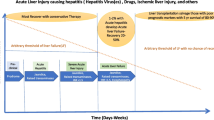Abstract
Background and Aims
Traditional laboratory markers are insensitive in distinguishing between patients with acute liver failure (ALF) who will require urgent liver transplantation (LT) from those who will recover spontaneously, particularly within 24 h of presentation. Coagulation factor-V (FV) may improve the accuracy of outcome prediction in ALF due to its predominant synthesis in the liver and short half-life in plasma.
Methods
Patients enrolled in the ALF Study Group Registry from a single site had FV determined within 24 h of presentation (Derivation-Cohort). Area under the receiver operating characteristic curves (AUROC) dichotomized by ALF etiology [acetaminophen (APAP) or non-APAP] were constructed to evaluate the diagnostic performance of FV for transplant-free-survival (TFS). Multivariate logistic regression modeling was performed using FV and other clinical variables to predict TFS. Accuracy of FV and multivariable model were performed in a Validation-Cohort from a different site.
Results
90-patients (56% with APAP) were included in the Derivation-Cohort. Median FV was significantly higher in TFS versus those who died/LT (31% vs. 15%, respectively; p = 0.001). When dichotomized by etiology, AUROC for FV was 0.77 for APAP (cutoff, sensitivity, specificity 10.5%, 79%, 69%, respectively) and 0.77 for non-APAP (22%, 85%, 67%, respectively). When the optimal cutoffs for FV in the Derivation-Cohort were applied to the Validation-Cohort (N = 51; 59% with APAP), AUROC for FV was 0.75 for APAP (sensitivity/specificity 81/44) and 0.95 for non-APAP (sensitivity/specificity 90/73). In multivariate analyses, AUROC for FV model was 0.86 in the Derivation-Cohort and 0.90 in the Validation-Cohort.
Conclusion
Admission FV may improve selection of patients who are likely to improve without LT.

Similar content being viewed by others
Abbreviations
- ALF:
-
Acute liver failure
- HE:
-
Hepatic encephalopathy
- TFS:
-
Transplant-free survival
- LT:
-
Liver transplantation
- FV:
-
Factor V
- NAC:
-
N-acetylcysteine
- APAP:
-
N-acetyl-p-aminophenol (acetaminophen)
- INR:
-
International normalized ratio of the prothrombin time
- VCU:
-
Virginia Commonwealth University
- IU:
-
Indiana University Hospital
- SD:
-
Standard deviation
- IQR:
-
Interquartile range
- AUROC:
-
Area underneath the receiver characteristic
- CI:
-
Confidence interval
- Sens:
-
Sensitivity
- Spec:
-
Specificity
- NPV:
-
Negative predictive value
- PPV:
-
Positive predictive value
- AIC:
-
Akaike information criterion
- MELD:
-
Model for end-stage liver disease
- ALFSG:
-
Acute liver failure study group prognostic index
- KCC:
-
Kings College Criteria
References
Lee WM, Stravitz RT, Larson AM. Introduction to the revised American Association for the Study of Liver Diseases Position Paper on acute liver failure 2011. Hepatology. 2012;55:965–967.
Reuben A, Tillman H, Fontana RJ, et al. Outcomes in adults with acute liver failure between 1998 and 2013: an observational cohort study. Ann Intern Med. 2016;164:724–732.
Bernal W, Wendon J, Rela M, Heaton N, Williams R. Use and outcome of liver transplantation in acetaminophen-induced acute liver failure. Hepatology. 1998;27:1050–1055.
O’Grady JG, Alexander GJ, Hayllar KM, Williams R. Early indicators of prognosis in fulminant hepatic failure. Gastroenterology. 1989;97:439–445.
McPhail MJ, Wendon JA, Bernal W. Meta-analysis of performance of Kings’s College Hospital Criteria in prediction of outcome in non-paracetamol-induced acute liver failure. J Hepatol. 2010;53:492–499.
Koch DG, Tillman H, Durkalski V, Lee WM, Reuben A. Development of a model to predict transplant-free survival of patients with acute liver failure. Clin Gastroenterol Hepatol. 2016;14(1199–1206):e1192.
Bernuau J, Goudeau A, Poynard T, et al. Multivariate analysis of prognostic factors in fulminant hepatitis B. Hepatology. 1986;6:648–651.
Bismuth H, Samuel D, Castaing D, et al. Orthotopic liver transplantation in fulminant and subfulminant hepatitis. The Paul Brousse experience. Ann Surg. 1995;222:109–119.
Bismuth H, Samuel D, Gugenheim J, et al. Emergency liver transplantation for fulminant hepatitis. Ann Intern Med.. 1987;107:337–341.
Pereira LM, Langley PG, Hayllar KM, Tredger JM, Williams R. Coagulation factor V and VIII/V ratio as predictors of outcome in paracetamol induced fulminant hepatic failure: relation to other prognostic indicators. Gut. 1992;33:98–102.
Izumi S, Langley PG, Wendon J, et al. Coagulation factor V levels as a prognostic indicator in fulminant hepatic failure. Hepatology. 1996;23:1507–1511.
Devictor D, Desplanques L, Debray D, et al. Emergency liver transplantation for fulminant liver failure in infants and children. Hepatology. 1992;16:1156–1162.
Harrison PM, Wendon JA, Gimson AE, Alexander GJ, Williams R. Improvement by acetylcysteine of hemodynamics and oxygen transport in fulminant hepatic failure. N Engl J Med. 1991;324:1852–1857.
Lee WM, Hynan LS, Rossaro L, et al. Intravenous N-acetylcysteine improves transplant-free survival in early stage non-acetaminophen acute liver failure. Gastroenterology. 2009;137:856–864.
Yantorno SE, Kremers WK, Ruf AE, Trentadue JJ, Podesta LG, Villamil FG. MELD is superior to King’s college and Clichy’s criteria to assess prognosis in fulminant hepatic failure. Liver Transplant. 2007;13:822–828.
Trey C, Davidson CS. The management of fulminant hepatic failure. Prog Liver Dis. 1970;3:282–298.
Conn HO, Leevy CM, Vlahcevic ZR, et al. Comparison of lactulose and neomycin in the treatment of chronic portal-systemic encephalopathy. A double blind controlled trial. Gastroenterology. 1977;72:573–583.
Stravitz RT, Lisman T, Luketic VA, et al. Minimal effects of acute liver injury/acute liver failure on hemostasis as assessed by thromboelastography. J Hepatol. 2012;56:129–136.
Holland LL, Foster TM, Marlar RA, Brooks JP. Fresh frozen plasma is ineffective for correcting minimally elevated international normalized ratios. Transfusion. 2005;45:1234–1235.
Funding
None for any author.
Author information
Authors and Affiliations
Contributions
Study Concept and Design: KRP and RTS, Data Analysis: KRP, MSG, JES and RTS, Manuscript Preparation: KRP, JES, and RTS, Manuscript Review: All authors.
Corresponding author
Ethics declarations
Conflict of interest
None for any author.
Additional information
Publisher's Note
Springer Nature remains neutral with regard to jurisdictional claims in published maps and institutional affiliations.
Electronic supplementary material
Below is the link to the electronic supplementary material.
Rights and permissions
About this article
Cite this article
Patidar, K.R., Davis, B.C., Slaven, J.E. et al. Admission Factor V Predicts Transplant-Free Survival in Acute Liver Failure. Dig Dis Sci 66, 619–627 (2021). https://doi.org/10.1007/s10620-020-06197-3
Received:
Accepted:
Published:
Issue Date:
DOI: https://doi.org/10.1007/s10620-020-06197-3




